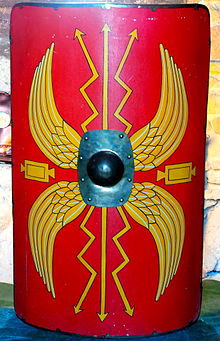Scutum (protective weapon)

The Scutum ( Latin , plural Scuta ; from Greek [τό] σκῦτος [tó] skȳtos , German '[the] leather' ) was a large oval, later rectangular, and always curved wooden shield . The scutum , also known as the “tower shield”, was part of the protective armament of the legionnaires of the Roman army .
construction
Initially oval in shape, the rectangular type prevailed in the middle of the 1st century AD. The shield, weighing around nine kilograms, was carried by a horizontal handle in the left hand. The rectangular scutum was about 120-130 cm high and about 60-70 cm wide. Over the circular recess for the handle, a wooden hump was attached to protect the hand and an often rectangular metal hump ( umbo ) was attached in front of it so that projectiles could slide off. In addition, it could even be used as a weapon, e.g. B. by ramming the opponent in the face or abdomen. It is possible that a stinger was attached to the umbo in the past to make it even more effective, but this is controversial.
The scutum consisted of three layers of wooden strips glued together at right angles, similar to today's plywood, with a total thickness of about 0.7-1 cm. The surface of the scutum was covered with linen or rawhide , sometimes also felt or leather , in order to prevent the shield from splitting open if hit . For the same purpose, the edges were covered with strips of sheet bronze. In addition, a bronze ridge was usually riveted in the longitudinal center, which gave the shield further stability. The shield painting varied from unit to unit.
The oval but flat shields of the auxiliary troops and cavalry ( Parma equestris ) are also to be distinguished from the oval scutum .
The Romans took over the scutum from the Samnites , but added a third layer of glued wood to it.
commitment
With its high weight, the scutum was a significant burden. Tactically, however, it was obviously of sufficient value to justify this disadvantage. Held in front of the body, its height protected almost the entire body; on the one hand, the arching made it very stable and, on the other hand, despite its size, it could still be guided around the body in close formation, as was necessary in a fencing match. In addition, the shield boss was suitable for ramming enemies. In the event of enemy fire, the legionaries were able to place the scutum on the ground and hide behind it completely.
During marches, the shields were placed in a cover ( tegimenta scuti ) made of leather to protect against moisture and dirt and hung over the back on two straps.
The scutum gained special importance in the turtle formation ( Testudo , see picture). The legionaries were set up so compactly that the dense rows of shields provided effective protection against fire for the entire group.
Use with gladiators
The scutum was also used in the arena as equipment for the gladiators . From the beginning, the equipment of the gladiators was largely based on the equipment of the Roman army. The shape and dimensions of the scuta of the secutores and murmillones correspond to those of the legionary infantry. The similarity between military and gladiatorial fighting techniques was striking. Now this shield was used in individual combat in the arena. This took a lot of practice. Individual combat techniques were retained, and the scutum was still in use among gladiators when it had long since become obsolete in the Roman army. In the gladiatorial battle scenes of the Borghese mosaics from the cryptoporticus of a villa in Torrenova on Via Casilina near the ancient Tusculum, the victorious secutor (?) Pampineus armed with a scutum can be found. The mosaic is dated to the beginning of the 4th century AD.
literature
- Marcus Junkelmann: The Legions of Augustus. The Roman soldier in the archaeological experiment . Zabern, Mainz 1986, 9th edition 2003, pp. 174-179, ISBN 3-8053-0886-8 .
- Ansgar Nabbefeld: Roman shields. Studies on finds and pictorial traditions from the end of the Republic to the late Imperial Era (= Cologne Studies on the Archeology of the Roman Provinces . Volume 10), Leidorf, Rahden, Westfallen 2008 ISBN 978-3-89646-138-4 (Dissertation University of Cologne 2007 , 284, 118 pages, illustrated, cardboard, 30 cm).
Web links
- die-roemer-online.de - More about Roman armament and equipment
- Antique originals can be viewed on the Roman Military Equipment page
- roemercohorte.de Private pages of the Römercohorte Opladen with further information on Roman military equipment



